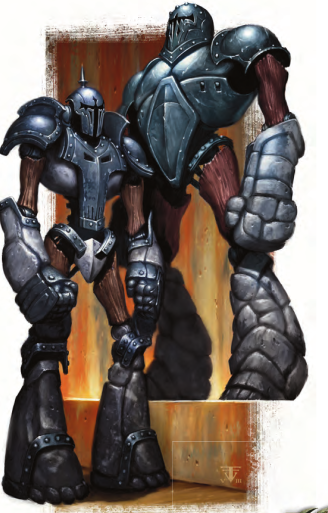Let's Read the 4e Monster Manual/Vault: Guardian

This article is part of a series! Click here to see the other entries.
I remember first reading about Shield Guardians in 3e, which is when you start getting a lot of new constructs that are not golems. I’m not sure if they appeared earlier than that or not. Guardians appear only on the MM here.
The Lore
A Guardian is a type of construct more specialized than a golem: it’s meant to act as a bodyguard. They’re smarter and more flexible than golems at this task, and easier to create. Unlike a golem, guardians are made of multiple materials: metal, wood, and stone. Every guardian is linked to an amulet that gets created alongside itself, and considers the holder of that amulet to be its master.
Guardians are good at detecting and intercepting threats to their master, and will also obey the master’s orders about as well as a generic golem. They can also be “programmed” to perform certain actions at specific times or when a specified condition is met.
When a guardian’s master dies it will keep performing its last orders, until someone else claims the amulet and becomes their new master.
The Numbers
We get two different stat blocks here. Both are Large Natural Animates with the Construct keyword, darkvision and Perception training. They’re also immune to charm, disease, fear, poison and sleep, which makes them sturdier than most golems in those areas.
Shield Guardian
The classic model is a Level 14 Soldier with 138 HP and all traits listed above. It walks at a plodding speed of 4 and attacks with Reach 2 Slams.
The main feature of a shield guardian is the Shield Other aura. It has a 2-square radius, and as long as the master is within it gives the master a +2 bonus to all defenses. The guardian also absorbs half the damage taken by the master while inside the aura.
The main job of a shield guardian is to stick close to its master, and punch any enemy who comes close. It’s equipped to do that and little else, but it’s good at its job.
Battle Guardian
Battle Guardians are the sort of bodyguard that runs out to engage the master’s enemies and cover their escape. They’re Level 17 Controllers with 163 HP and the common traits listed above. Their speed is a much more respectable 8.
The battle guardian’s basic slam does damage and immobilizes on a hit (save ends). While it remains adjacent to its master, the master’s movement doesn’t provoke opportunity attacks.
If an enemy ends the movement portion of a charge within 8 squares of the guardian (which will happen if they try to charge the master, for example), the guardian can use Block Charge as an interrupt. This is basically a counter-charge, taking place before the enemy can actually attack. If the battle guardian’s slam hits the enemy, they’re also knocked prone.
Sample Encounter and Final Impressions
The sample encounter is level 14: 1 shield guardian, 1 githzerai mindmage, and 4 gray slaads. The githzerai is obviously the master here, and it’s either a villain who consorts with slaads or a potential ally who is fighting the slads when the PCs meet them and has to be talked down before they’ll see the PCs as allies.
Guardians are OK, I suppose. Mechanically they do their jobs as designed, increasing the survivability of their master.
Narratively, they might seem a bit redundant given how crowded the design space is these days. It makes sense that artificers and wizards would come up with several different ways to make a loyal construct, given that they all want one and none of them is fond of sharing secrets. Having a huge variety of constructs detracts from their uniqueness while shining the spotlight on the idiosyncrasies of their creators, so it’s up to you which way you want to go.